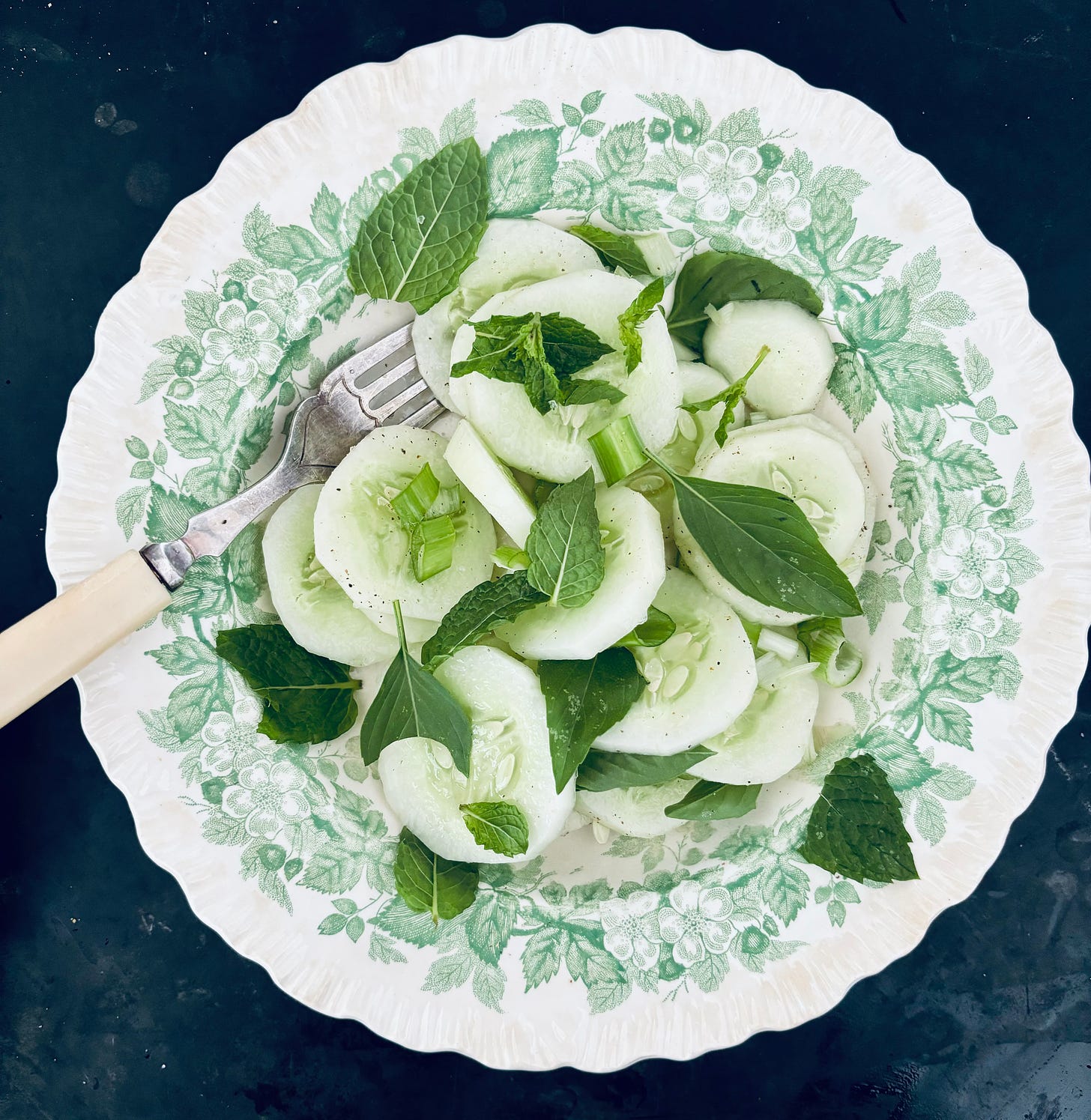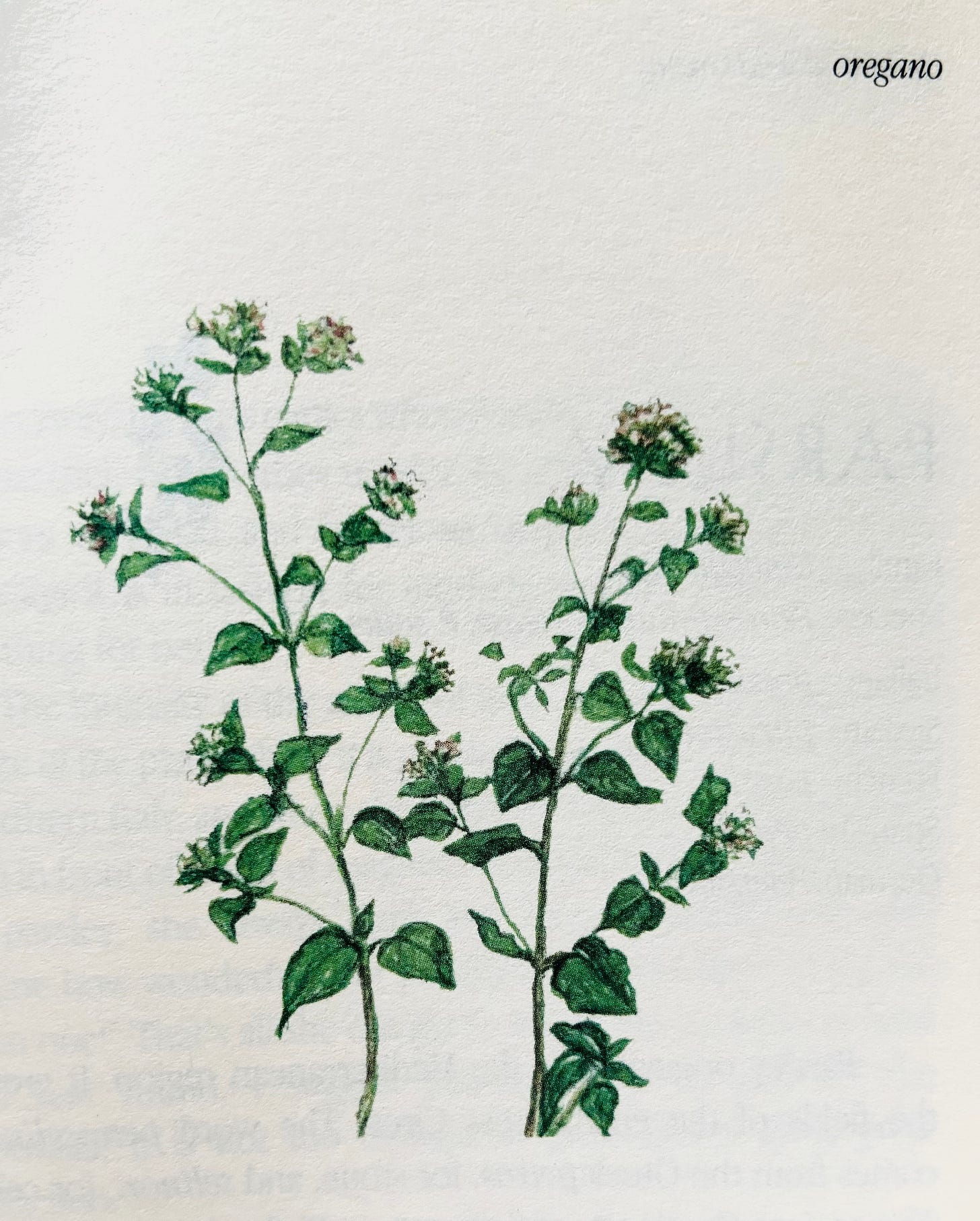If you have an herb garden, you can see time passing in front of you, and with it the many sweet and poignant thoughts that summer brings. Memories and regrets, we all have a few at this point of the season, when what seemed just a couple of weeks ago to be an endless expanse has been reduced to the inevitable and familiar countdown. Which reminds me that I need to use these leaves while I’ve got them.
The parsley has gone to seed, and the lively green bed of mint is no longer refreshing to look at, its stems turning brown. The veritable wall of dill umbrellas blocking the view of our picnic table from the road is starting to turn yellow and form clusters of tiny seeds. The rest of the herbs in my garden are trying to grow little buds. Especially the oregano. I’m told it’s more flavorful once it’s in bloom. So, it’s time to clip and dry the branches for the cooler months (scroll down to read how). That’s okay, I like it better dried than fresh anyway.
Of three types of basil we planted this year, my favorite is a small-leaf variety, with an intense, almost clove-like burn. I add it to my tomato salads, and my tuna salad too, why not? I think it’ll make great pesto. Pretty Thai basil romances my plates and my imagination. It has tall stalks and purple flowers that will shoot right up if I don’t catch them in time and nip them off with my fingertips. I add the leaves to cucumber salads, rice noodles, and glasses of iced tea.
For the time being, the best trick I’ve got up my sleeve is to use more herbs: More varieties, more combos, more places. Just Add More. Bright orange nasturtium flowers and their leaves are not just pretty– they are peppery additions to salads. Sage is always there for buttery, cheesy pasta, and if I feel like putting in a little extra effort, dipping in batter and frying until crisp to nibble with drinks. Mint is strewn over just-grilled zucchini along with garlic and a splash of red wine vinegar. Dill goes into potato salad, chicken salad, and pickles, of course. Lemon verbena awaits a pour-over of boiling water for a cleansing cup of after-dinner tisane. I clip a few leaves each time I walk by and add them to my perpetual water glass.
When you grow your own, you can be decadent with herbs. Shower platters with fragrant green leaves. Bring a posy of herbs along with a bottle of wine when invited to dinner. See how stylish you feel when you add a tall handful of Thai basil and mint to a pitcher of ice water and place it, like a vase of flowers, in the center of the table.
Some days I’m on deadline for a job. Recently, I wrote a “listicle” about DILL for the Martha Stewart Living website, and developed autumnal recipes for a cookware company. On the days when the pressure’s off, though, I like the float-in-and-out of the kitchen approach to summer cooking. I’ll call it the Summer Float. I’m aware of moving very slowly, like I’m just passing through the kitchen in my swimsuit or light dress, absolutely no commitment to the stove. On these quiet summer days, I lay a few ingredients down on a plate, thinking about texture and color, then choose which types of fresh herbs to use. The plate might hold tomatoes of all sizes and colors, or sliced cucumbers and spring onions, cooked beans. Olives, feta cheese, or mozzarella. Anchovies. Capers. Always olive oil. Almost no cooking. As I pluck the herbs from their stems, I take note of the scent in the air in a sort of meditation on this moment. And I love it.
Cucumber Slices With Mint
Slice a fresh cucumber (peel first if necessary).
Toss the slices with salt and sprinkle with rice wine vinegar.
You think this is too simple to be anything special? Now do the Summer Float:
Casually scatter mint and Thai basil leaves on top, add a blossom or two if you have them.
Voila! Pretty, and fragrant.
Lately, I’ve been reaching for a lovely, slim book by Anna Tasca Lanza called Herbs and Wild Greens From the Sicilian Countryside. It has her drawings throughout, and a few recipes. I like how the book feels in my hands. I received it from Fabrizia Tasca Lanza when I was a guest at her family’s historic estate in the Sicilian countryside. They host workshops and culinary classes there. I was there for a cozy and inspiring writing workshop called The Language Of Food, led by the inimitable food writers, Rachel Roddy and Luisa Weiss. We tasted the ten varieties of mint growing in the courtyard, nibbled on fried sage leaves, and wrote from Rachel and Luisa’s prompts while sitting in the herb garden. Reading this lovely little book now takes me away to the very beautiful rolling landscape around Case Vecchie, where oregano bushes “Named Splendor of the mountains” by the Greeks “grow wild, choosing the rocky and arid fields, the coasts or the mountains, as long as the place is sunny”.
In this personal book, Anna gives detailed instructions for drying and saving oregano, and I love the kind of care she takes in describing how:
“To get the best fragrance, pick oregano as soon as the plant is in bloom. Hang the bunch in the shade until it is dry, and then in the sun until it is brittle. If the sun is not shining, put it in a very low oven. Crush the oregano between the palms of your hands by rubbing them one against the other. Do this over an open newspaper so as not to lose any of the leaves. Sift it, then put it in a glass jar and close it tight. Oregano is sold everywhere in the markets, but you should smell it before you pay for it. That is the only way to tell that it is not from last year’s crop.”
Well, okay– the last two sentences might only be a fantasy for those of us who don’t live in Sicily or Greece, where you can smell dried oregano before purchasing, where you even have a choice. But to me, the combination of useful information and bits of language that help me imagine what it’s like to see a place from where the writer stands is what can make food writing so compelling. It helps me dream. Now, back to the Summer Float.
While standing in bare feet, stir a simple and aromatic salsa verde in a jar. Spoon it onto grilled things (swordfish, bluefish, lamb chops, zucchini, eggplant…) that can stand up to strong flavors.
Oregano, Mint and Caper Salsa Verde
The combination of mint and oregano is not traditional, yet I find it surprisingly harmonious. The two herbs play high and low notes together; one lifting and one low, sweet/ one pungent, pretty/ scrubby. Stirred into a simple salsa verde riff, the duo is just right. Notice I am using oregano in both its dried and fresh state. You don’t have to! If you only have dried (or fresh) it’s still good. This should not be a thin dressing, and not too acidic. It should be packed with flavor, herbs and capers. A little goes a long way. This is for a small batch and I’m guessing the amounts here are just suggestions. Stir it up and add more of what you like.
1 fat garlic clove, finely grated or chopped
Lemon juice 1 Tbsp
Red wine vinegar 2 tsp
coarse salt
Dried oregano, 2 tsp
Capers, 2 Tbsp, rinsed and chopped (soaked first if the salted type)
Fresh oregano, finely chopped (1 Tbsp)
Fresh mint, coarsely chopped (2 Tbsp)
Extra virgin olive oil 3 Tbsp or more
Stir the garlic with lemon, vinegar, salt, dried oregano, and capers in a small bowl. Let stand while you grill whatever it is you’re grilling. Add the fresh herbs and whisk in the olive oil.
Drawing below by Anna Tasca Lanza








Thank you! Love to herbs, and you.
This was transporting. I will make that salsa verde with oregano from Ninetta in Ponza & capers from Linosa that I bought in Testaccio & float through my little Venetian kitchen